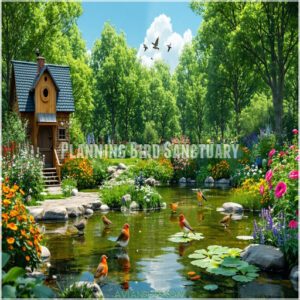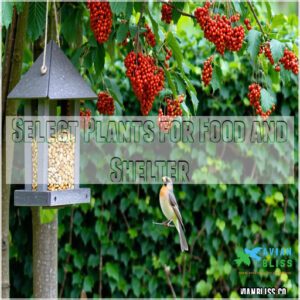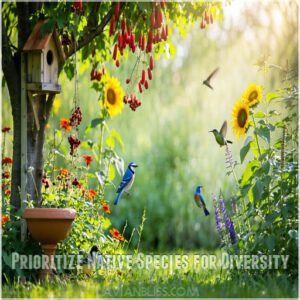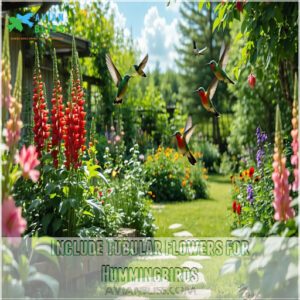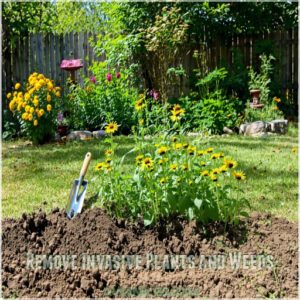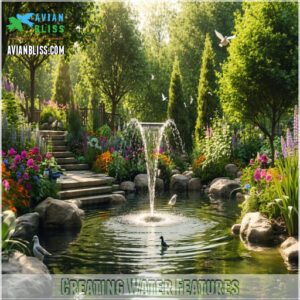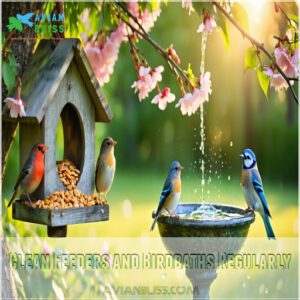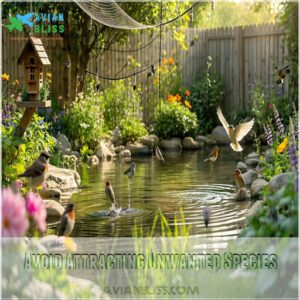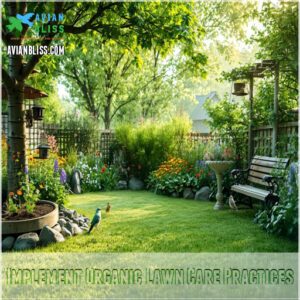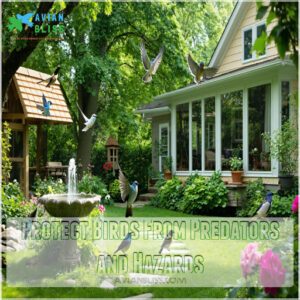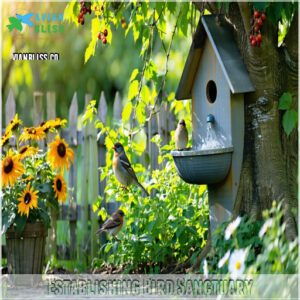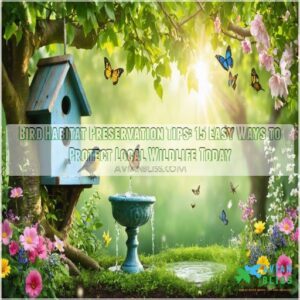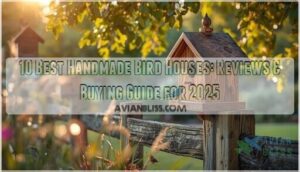This site is supported by our readers. We may earn a commission, at no cost to you, if you purchase through links.
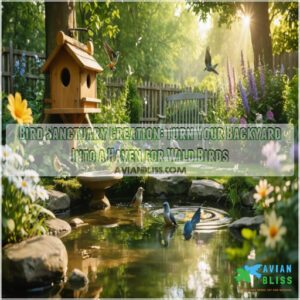
To start, you’ll research local bird species, assess your yard’s size and layout, and identify open spaces with native vegetation.
Choose native plants that provide food and shelter for diverse bird species.
Consider the sanctuary’s boundaries, and provide essential resources like food, water, and shelter.
By following these steps, you’ll be well on your way to establishing a thriving bird sanctuary, and that’s just the beginning of turning your backyard into a haven for wild birds.
Table Of Contents
- Key Takeaways
- Planning Bird Sanctuary
- Choosing Native Plants
- Creating Water Features
- Maintaining Bird Habitat
- Establishing Bird Sanctuary
- Frequently Asked Questions (FAQs)
- How to create a bird-friendly sanctuary?
- Should you build a bird sanctuary?
- What makes a bird sanctuary a sanctuary?
- How do I accredit a bird sanctuary?
- Why should you create a wildlife sanctuary?
- Are gardens and sanctuaries bird-friendly?
- How to establish a bird sanctuary?
- What qualifies as a bird sanctuary?
- What makes something a bird sanctuary?
- What was the first bird sanctuary in the United States?
- Conclusion
Key Takeaways
- You’ll create a thriving ecosystem by transforming your yard into a bird sanctuary, providing food, water, and shelter for diverse bird species.
- To get started, you’ll research local bird species, assess your yard’s size and layout, and identify open spaces with native vegetation that can support your feathered friends.
- You’ll need to maintain your bird sanctuary by regularly cleaning feeders and birdbaths, using organic lawn care practices, and protecting birds from predators and hazards like cats and pesticides.
- By establishing a bird sanctuary, you’ll not only attract birds to your yard, but you’ll also be supporting local ecosystems, preserving biodiversity, and making a positive impact on the environment and wildlife conservation.
Planning Bird Sanctuary
You’ll need a solid plan to transform your backyard into a bird sanctuary, starting with research about local bird species and an assessment of your yard’s layout.
Your first steps include checking the amount of available space, identifying existing trees and plants, and marking clear boundaries for your new sanctuary area.
These steps are crucial for creating an environment that attracts and supports local bird life, and by following them, you can turn your yard into a thriving haven for birds.
Research Local Bird Species
Before creating your bird sanctuary, you’ll need to become familiar with your local bird populations.
Here’s how to start your species identification journey:
- Download the free eBird database to track weekly bird patterns and common species in your region
- Learn to identify birds through physical traits like size, beak type, and seasonal plumage changes
- Master bird songs and calls to spot species even when they’re hidden from view
- Connect with local birding groups to share sightings and gain insights about bird migration patterns
- Explore the free eBird checklist program to record your observations and contribute to citizen science.
Assess Yard Size and Layout
Before transforming your yard into a bird sanctuary, take a careful look at your current layout.
Walk around to evaluate the overall space and observe existing features like trees, sunlight patterns, and structures.
With smart space optimization, even small patios or porches can become vibrant sanctuaries.
Providing essential resources for birds like food, water, and shelter is necessary for attracting them to your backyard.
Your site analysis should consider natural traffic patterns and potential bird-friendly zones for effective landscape design.
Identify Open Spaces and Vegetation
Your first job in bird sanctuary design is checking what natural features you’re working with.
Survey your yard’s existing habitat, including mature trees, natural clearings, and established shrubs.
When performing Tree Mapping, look for spots where birds already gather.
Good Space Planning means understanding how sunlight patterns affect different areas.
A quick Land Survey and Soil Testing will help you pick native plants that’ll make your backyard bird sanctuary thrive in your local ecosystem.
Determine Sanctuary Boundaries
While planning your backyard bird sanctuary location, you’ll need to carefully map out the boundaries to create distinct zones.
Consider ideal birdhouse placement to attract desired species.
Here are key steps for effective boundary mapping:
- Survey your land to identify natural divisions like trees, shrubs, or existing fences
- Mark potential areas for fence installation that won’t disrupt flight paths
- Consider your habitat size needs based on local bird populations
Remember to leave buffer zones between your sanctuary and busy areas to help birds feel secure and attract the desired bird species with effective boundary mapping.
Choosing Native Plants
You’ll find that native plants are nature’s perfect bird buffet, as they support over 500 species of insects that birds need for food while providing essential shelter and nesting spots.
Your local native oak tree will attract fifty times more birds than non-native plants like ginkgo, making it an excellent choice for transforming your yard into a thriving bird sanctuary, which also serves as a bird buffet.
Select Plants for Food and Shelter
After mapping your space, it’s time to create nature’s perfect bird buffet and hotel.
Native plants evolved alongside our feathered friends, offering exactly what they need to thrive.
You can find a variety of native bird plants online.
Your yard can become a bird grocery store and apartment building with the right plant picks.
| Plant Type | Food Value | Shelter Benefits |
|---|---|---|
| Dogwood | Year-round berries | Dense nesting cover |
| Arborvitae | Winter seeds | Year-round shelter |
| Golden Alexander | Butterfly attraction | Protective cover |
| Goldenrod | Small bird seeds | Natural hideaway |
These bird-friendly plants will transform your space into a vibrant sanctuary where birds can feast and rest safely.
Research shows native habitat is the most critical factor for bird survival.
Prioritize Native Species for Diversity
Your native plant selection forms the backbone of a thriving bird sanctuary .
These local species have spent thousands of years developing perfect partnerships with your area’s birds.
Native plant societies can guide you in picking vegetation that supports local wildlife, from ground cover to towering trees.
When you include at least 70% native species in your sanctuary, you’re creating a sustainable habitat that naturally attracts diverse bird populations while needing less maintenance.
This structure supports the local ecosystem and helps in maintaining a healthy environment for the birds, with the native plants being the key to a successful wildlife sanctuary.
Include Tubular Flowers for Hummingbirds
Beautifully designed tubular flowers serve as nature’s perfect nectar sources for your local hummingbirds.
Plant red cardinal flowers, which provide essential late-summer food, alongside bee balm and penstemon in your birdfriendly garden .
These pollinator plants offer exactly what these aerial acrobats need, with their bill-friendly blooms creating natural hummingbird feeders that are far better than artificial alternatives.
Remove Invasive Plants and Weeds
You’ll need to act quickly when spotting invasive species in your bird sanctuary – these aggressive plants can rapidly overwhelm native vegetation.
Focus your weed control efforts on complete root removal, then immediately replant with indigenous species that local birds recognize and rely on.
Regular monitoring helps maintain ecosystem balance, ensuring your native plant restoration creates lasting habitat value .
Avoid composting any seeding invasive plants, and remember that complete root removal is crucial.
Creating Water Features
You’ll need to add clean, fresh water sources to your backyard sanctuary since birds require water not just for drinking but also for bathing and staying cool.
While birdbaths are a good start, you can create an even more appealing water feature by adding small fountains or ponds with sloping edges that allow birds to wade at different depths, making it an ideal spot for birds to stay cool.
Install Bird Feeders and Birdbaths
Three key steps make feeder placement a breeze for your bird watching sanctuary.
Mount feeders 5-10 feet high for ideal visibility, keeping them away from dense foliage for clear flight paths.
Choose feeder types that suit local birds, and fill them with high-quality birdseed.
Consider ideal bird bath and feeder combos for attracting various species.
For your birdbath, select a spot with partial shade so the water stays cool and inviting, creating an ideal bird watching experience with a well-placed birdbath.
Provide Water Sources for Hydration
Beyond bird baths, your backyard can become a bustling hub of bird activity with varied water sources.
Setting up different water features helps birds drink, bathe, and preen their feathers.
Rain barrels and drip systems with wigglers attract attention, while shallow water ponds create natural drinking spots.
Consider a heated bird bath product to provide liquid water during winter.
- Heated water sources keep birds hydrated even during freezing winter days
- Moving water from fresh springs naturally draws curious birds to explore
- Multiple birdbaths at varying heights, filled with clean pebbles, let everyone from tiny finches to robust jays drink safely
Maintain Water Quality and Accessibility
Clean water keeps your feathered friends healthy and happy.
Regular maintenance of your water features guarantees birds return to your sanctuary again and again. You can purchase bird bath cleaning products to maintain cleanliness.
| Task | Frequency |
|---|---|
| Change water | Daily |
| Scrub surface | Weekly |
| Check filter systems | Monthly |
| Test water quality | Seasonally |
| Deep clean | Quarterly |
For pristine birdbaths and water sources, use bird-safe algaecides and add beneficial bacteria to prevent stagnation. Remember to wipe away debris daily and maintain proper water circulation through pond aeration – your avian visitors will thank you with their continued presence.
Incorporate Ponds or Wetlands
A thoughtfully designed pond creates a vibrant ecosystem where birds gather to drink, bathe, and thrive.
When incorporating water features like ponds or wetlands into your backyard sanctuary, focus on creating natural gradations and diverse habitats.
- Add a pump or small filter to keep pond water oxygenated and moving, which attracts more birds while maintaining water quality
- Create shallow, sloped shoreline buffers with wetland margins to support different species and promote biodiversity
- Include natural features like brush piles and rock walls near the water’s edge for shelter and safety
- Install a dripper or mister above your pond to keep birds cool and create additional habitat options
Maintaining Bird Habitat
You’ll need to maintain your backyard bird sanctuary by regularly cleaning feeders and birdbaths to prevent diseases from spreading among your feathered visitors.
To keep your bird habitat healthy, you should also use organic lawn care practices and protect birds from common hazards like cats and pesticides.
Clean Feeders and Birdbaths Regularly
You clean feeders, birdbaths regularly to prevent disease, using a 10% bleach solution.
For ideal bird bath hygiene, prioritize regular cleaning practices regular cleaning practices.
| Feeder Type | Cleaning Frequency |
|---|---|
| Hanging | Every 2 weeks |
| Tray | Every 1 week |
| Tube | Every 2 weeks |
| Ground | Every 1 week |
| Suet | Every 2 weeks |
The provided table outlines the cleaning frequency for different types of feeders, including hanging and ground feeders, to maintain hygiene and prevent the spread of disease.
Avoid Attracting Unwanted Species
To avoid attracting unwanted species, use pest control methods like netting systems, repellent plants, and boundary fencing to keep deer, raccoons, and bears away.
Consider species exclusion techniques to deter outdoor cats and other pests from your bird sanctuary.
Implement Organic Lawn Care Practices
To maintain your bird-friendly backyard, you’ll want to implement organic lawn care practices.
This includes:
- Using compost
- Testing soil
- Applying natural fertilizers
- Aerating your lawn, all of which create a healthy environment for native plants to thrive, promoting a healthy environment.
Protect Birds From Predators and Hazards
To protect birds from predators and hazards, remove pest attractants, install netting, and use visual decals to prevent window strikes.
Creating a bird-friendly habitat with effective predator control and hazard removal, ensuring bird safety and nest protection in your wildlife conservation area, is a vital part of bird conservation.
Establishing Bird Sanctuary
You’re now ready to establish a bird sanctuary, and it starts with designating a specific area for your backyard haven.
By planting native vegetation, providing nesting materials, and installing birdhouses, you’ll create a welcoming space for wild birds to thrive and visit regularly.
Designate Specific Area for Sanctuary
When establishing your bird sanctuary, you’ll designate a specific area.
Consider:
- Area Selection
- Boundary Marking
- Site Preparation
- Zone Mapping, to create a haven, focusing on bird sanctuary planning and habitat zoning to establish a backyard bird sanctuary.
Plant Native Vegetation for Food and Shelter
Now that you’ve designated your sanctuary area, you’ll want to plant native vegetation for food and shelter.
Creating a bird-friendly habitat involves careful planning and selection of native plants.
| Native Plants | Soil Preparation | Vegetation Density |
|---|---|---|
| coneflower | fertile soil | medium |
| black-eyed susan | well-drained | high |
| cosmos | moist soil | low |
The selection of native plants and their requirements, as shown in the table, is crucial for a successful bird-friendly habitat.
Provide Nesting Materials and Birdhouses
You’re creating a bird-friendly habitat, now provide nesting materials and birdhouses.
Offer natural materials like twigs, feathers, and moss, and install nesting boxes or birdhouses made from durable, untreated wood.
Supporting bird species conservation and a thriving bird sanctuary with roosting sites and nesting materials.
Monitor and Adapt to Changing Bird Needs
As you provide nesting materials, remember to monitor and adapt to changing bird needs.
Considering bird behavior, climate change, and habitat shifts, is crucial to maintain a thriving backyard bird sanctuary.
This adaptation supports bird species conservation and population trends in your bird conservation area, to protect bird habitat.
Frequently Asked Questions (FAQs)
How to create a bird-friendly sanctuary?
You’ll need a million trees, but start small, planting native species, and adding water sources to attract birds, making your yard a haven for them to thrive and visit.
Should you build a bird sanctuary?
You should consider building a bird sanctuary if you’re passionate about conservation and have space, as it can be a rewarding experience, supporting local ecosystems and biodiversity.
What makes a bird sanctuary a sanctuary?
Actions speak louder than words" – you’ll make a sanctuary by offering food, water, shelter, and safety, letting birds thrive in a protected, natural environment, free from harm.
How do I accredit a bird sanctuary?
You’ll apply for accreditation through organizations like the Global Federation of Animal Sanctuaries, ensuring your sanctuary meets rigorous standards for animal care and welfare.
Why should you create a wildlife sanctuary?
You’ll create a haven, protecting species, preserving ecosystems, and educating communities, ultimately making a positive impact on the environment and wildlife conservation, which benefits you and future generations greatly.
Are gardens and sanctuaries bird-friendly?
You can make gardens and sanctuaries bird-friendly by planting native vegetation, providing water sources, and minimizing pesticide use, making them welcoming habitats for various bird species to thrive.
How to establish a bird sanctuary?
You’ll start by choosing a suitable location, then plant native vegetation, and install water sources, to establish a thriving bird sanctuary, providing a safe haven for various species.
What qualifies as a bird sanctuary?
Imagine a haven for birds, you’ll need a protected area with diverse habitats, food, water, and shelter to qualify as a bird sanctuary.
Providing a safe space for them to thrive naturally.
What makes something a bird sanctuary?
You’ll know it’s a bird sanctuary when you see protected habitats, food sources, and nesting areas, all working together to support local bird populations and their unique needs naturally.
What was the first bird sanctuary in the United States?
You’ll discover that the first bird sanctuary in the United States was Plum Island, established in 1937, offering a safe haven for migratory birds.
Conclusion
By creating a bird sanctuary, you’re transforming your yard into a thriving ecosystem, which is a stark contrast to a typical backyard.
You’ll attract diverse species, providing them with food, water, and shelter.
Your bird sanctuary creation efforts will pay off, making your outdoor space a haven for wild birds, and a rewarding bird sanctuary creation experience awaits you.
- https://www.angi.com/articles/creating-wildlife-habitat-your-backyard.htm
- https://bowerandbranch.com/blogs/native-trees-and-plants/how-to-build-a-bird-sanctuary-in-your-backyard
- https://www.audubon.org/news/how-make-bird-friendly-sanctuary
- https://constitution.audubon.org/news/how-create-bird-sanctuary
- https://valleyfarms.shop/blogs/news/5-steps-to-building-your-own-bird-sanctuary

